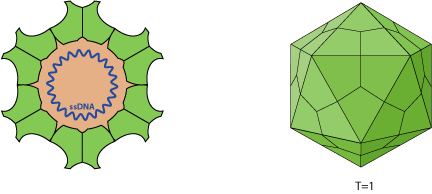VIRION

Non-enveloped, round, T=1 icosahedral symmetry, about 17 nm in diameter. The capsid consists of 12 pentagonal trumpet-shaped pentamers.
GENOME
Monopartite, circular, ssDNA genome of about 1800 to 2000bp.
The genome is replicated through double-stranded intermediates. The replication (Rep) protein initiates and terminates rolling circle replication, the host DNA polymerase being used for DNA replication itself. There is a potential stem-loop structure in the intergenic region that includes a conserved nonanucleotide sequence (AGTATTAC) where ssDNA synthesis is initiated.
GENE EXPRESSION
The encapsidated viral DNA and the complementary DNA of the replicative intermediate encode two mRNAs for the Rep and capsid proteins.
Rep mRNA can undergo alternative splicing in some strains to produce Rep' protein.
ENZYMES
REPLICATION
NUCLEAR
- Virus penetrates into the host cell probably by clathrin- and caveolae-independent endocytosis.
- Uncoating, the viral ssDNA genome penetrates into the nucleus.
- Viral ssDNA is converted into dsDNA with the participation of cellular factors. dsDNA transcription gives rise to viral mRNAs.
- Viral mRNAs are translated to produce viral proteins.
- Replication may be mediated by a Rep protein, and would occur by rolling circle producing ssDNA genomes.
- These newly synthesized ssDNA can either
a) be converted to dsDNA and serve as a template for transcription/replication
b) be encapsidated by capsid protein and form virions released by cell lysis.

